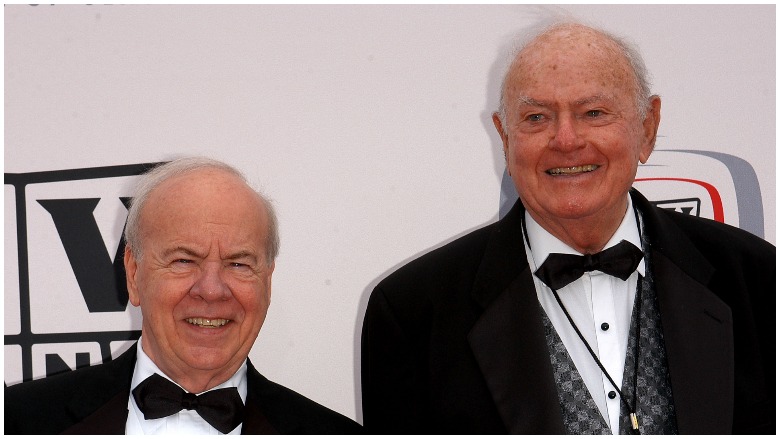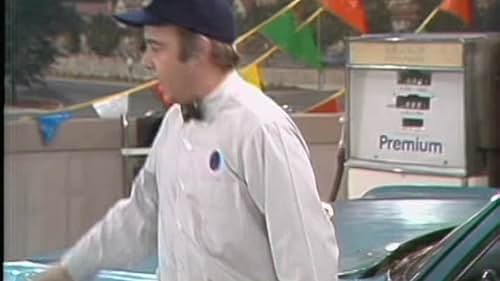When a Bank Robber Pulls Into the Worst Gas Station Imaginable ⛽💥 — The Tim Conway & Harvey Korman Classic That Still Leaves Fans in Tears After All These Years 😂🎭
During television’s golden era of variety shows, few performers could transform escalating madness into polished comedic brilliance the way Tim Conway and Harvey Korman consistently did. Their chemistry reached one of its highest points in The Carol Burnett Show’s now-iconic “Gas Station Robbery” segment — a tightly packed burst of perfectly timed gags, deliberate awkward pauses, and improvised reactions that blended into a six-minute spectacle. It remains a shining example of comedy where every small detail, from Conway’s blank stare to Korman’s unraveling patience, becomes essential to the laughter.
First broadcast in Season 6, Episode 17 back in 1973, the bit starts with a tone closer to crime drama than sketch comedy. Harvey Korman’s jittery bank robber barrels down the road, loot beside him, police sirens echoing behind. His nerves are stretched thin, fear and adrenaline colliding as he tries to disappear before anyone spots him. But just when relief feels within reach, reality hits with cruel timing, and his frantic escape plan falls apart in the most inconvenient way imaginable.
His getaway car suddenly coughs, jerks, and gives up entirely — the tank is bone dry. The silence that follows feels heavier than the chase itself. Korman steps out, visibly shaken, realizing he has no choice but to deal with this new disaster before the authorities catch up. That moment sets the stage for the absurd journey ahead, where every attempt he makes to regain control only drags him deeper into Conway’s world of unhurried confusion.
Then the real trouble begins, as fate delivers him to a nearly deserted roadside station with only one pump and even fewer signs of competence. What looks like a simple detour quickly becomes a spiraling catastrophe. Instead of finding quick salvation, he steps into a universe governed entirely by Conway’s blissful obliviousness. What should have been a brief pause turns into a chain reaction of delays, misunderstandings, and patience-shredding calm.
Conway’s attendant appears with the attitude of someone on a vacation rather than a job, strolling into frame with disarming cheerfulness. He behaves as though time moves differently for him, unaffected by urgency, alarms, or the frantic man begging for speed. He’s the sort of worker who would stop mid-task to admire a pebble or ponder the clouds, and Korman, desperate to flee, has no idea how to manage the mounting chaos that follows.
The clash between Korman’s desperation and Conway’s molasses-slow pace becomes the heartbeat of the scene. Instead of rushing, Conway meticulously checks the windshield, taps on the tires, comments on the weather, and treats the entire interaction as a leisurely social visit. With every unnecessary pause, the audience can feel Korman’s frustration rising, while Conway remains blissfully unaware of the growing emotional storm beside him.
By the time Conway finally reaches for the gas pump — twisting it, rotating it, and placing it everywhere except the actual fuel tank — Korman appears moments away from collapsing under the weight of disbelief. What should be the simplest task becomes an almost artistic display of incompetence, stretching the absurdity far beyond what anyone expects, and setting the stage for the sketch’s most unforgettable moments.
💥 The Setup: A Getaway Gone Wrong
When Korman’s character pulls into the dingy station, he immediately realizes that Conway is the absolute worst person to encounter during a high-stakes escape. Conway’s blank expression, wandering focus, and molasses-slow movements create a living nightmare for someone racing against time. The robber’s shouted pleas for haste bounce right off Conway, who seems incapable of comprehending urgency even when a man sweating bullets hovers inches away from him.
Every moment intensifies the disconnect between them. Conway treats the interaction like a mid-afternoon chat over lemonade rather than a frantic pit stop involving a criminal mid-flight. He fusses with the car’s exterior, begins unnecessary small talk, and pauses as though pondering deep philosophical questions. Each second wasted feels like an eternity to Korman, whose frantic energy only makes Conway’s stillness more hilarious.
The slow-motion disaster reaches new heights as Conway clumsily wrestles with the gas pump, positioning it backward, lifting it uselessly into the air, and examining it with the confusion of someone handling it for the very first time. Korman’s facial expressions during this debacle tell an entire story — disbelief, rage, pleading, and ultimately resignation — all while the audience erupts in laughter at the widening emotional gap between the two men.
🤣 Harvey Korman’s Legendary Meltdown

The brilliance of the scene isn’t only in the physical humor — it’s in the tension that builds from Conway’s measured stillness. He weaponizes silence, turning pauses into punchlines and blank stares into comedic ammunition. As Conway remains impossibly calm, Korman struggles to maintain composure, and the struggle becomes part of the entertainment. The audience watches him fight a losing battle against his own laughter as Conway keeps ramping up the absurdity.
Viewers can witness Korman’s unraveling in real time: his mouth twitches, his eyes dart as he tries to look anywhere except at Conway, and his shoulders tremble uncontrollably. Every attempt he makes to recover professionalism only makes his eventual break more satisfying. It’s a rare moment when a performer laughing on camera becomes funnier than the scripted joke, and Conway knows exactly how to push him right to that edge.
Sensing his partner’s vulnerability, Conway leans fully into the chaos — misplacing the gas cap, shifting his body awkwardly, and delivering that now-famous deadpan line: “You want regular or the good stuff?” The audience explodes, the crew can barely hold the cameras steady, and Korman collapses into helpless, uncontrollable laughter. Meanwhile, Conway carries on without breaking character for a second, pumping fuel with mind-numbing slowness as if nothing unusual is happening.
⛽ A Masterclass in Slow Comedy
The charm of the sketch lies in its refusal to rush toward a punchline. Instead of firing off rapid jokes, it builds hilarity through repetition, hesitation, and rhythm. Modern audiences, accustomed to rapid-fire comedy, rarely get scenes that stretch a single premise this far without losing momentum. But Conway and Korman use every delayed beat to elevate the comedy, proving that slowing down can sometimes produce the biggest laughs.
Carol Burnett once remarked that Conway possessed a rare gift — he could make nothing funny. A glance, a breath, even standing still became material when he performed it. Korman, meanwhile, was the perfect foil: expressive, emotional, and always on the edge of breaking down. Together, they created a dynamic few comedy duos have ever matched, turning even silence into a setup for explosive humor.
The “Gas Station” sketch is now dissected by comedy students for its structure. Every pause is intentional, every mistake crafted to look accidental, and every reaction carefully balanced between exaggeration and realism. Conway wasn’t acting like a fool — he embodied someone naturally unaware, and his sincerity made Korman’s unraveling not only believable, but irresistible. It’s an enduring reminder that comedy doesn’t always need noise to make an impact.
🚓 The Ending — and the Eternal Payoff

As the sirens grow louder in the distance, Korman’s anxiety reaches its peak. Every passing second feels like a countdown to disaster, yet Conway moves as if the world is frozen around him. When he finally finishes filling the tank, the moment appears almost hopeful — until he casually adds that checking the oil will take several more minutes. It’s a line that pushes Korman completely over the edge, triggering one last wave of explosive frustration.
Korman’s cry of despair practically reverberates through the studio, capturing the exact moment he realizes he’s trapped in a nightmare he can’t escape. His exaggerated meltdown adds another layer of hilarity, blending scripted chaos with genuine emotional release. For the audience, it’s the perfect capstone to a sketch already teetering between absurdity and brilliance, and it seals the performance as one of the duo’s most memorable collaborations.
When the sketch concludes, Korman’s character peels away in frantic desperation, while Conway lifts a hand in cheerful farewell, utterly oblivious to the whirlwind he has caused. The contrast between them — one overwhelmed, one unbothered — crystallizes the essence of their comedic partnership. It’s a finale that brings the entire absurd journey full circle, leaving viewers breathless with laughter long after the screen fades to black.
🎬 Fifty Years Later, Still Comedy Gold
More than fifty years after it first aired, the “Gas Station Robbery” sketch continues to circulate online, captivating new audiences with the same effortless charm. Fans of all ages praise it as the epitome of classic comedy, highlighting how its humor relies not on shock or spectacle but on skill, timing, and chemistry. In a digital era dominated by rapid content, the sketch proves that slow-burning humor remains timeless.
For those who grew up with The Carol Burnett Show, revisiting the scene feels like stepping back into a world where comedy was crafted with care, patience, and spontaneity. It showcases the kind of unfiltered joy that made the series legendary, reminding viewers why Conway and Korman’s partnership left such an enduring mark on television history. Their performances feel just as alive now as they did in the ’70s.
Anyone wondering how a simple interaction at a lonely gas station turned into one of television’s greatest comedic moments only needs to look at the performers themselves. Conway’s commitment to deadpan absurdity and Korman’s explosive reactions formed a perfect storm of comedic brilliance, elevating a straightforward premise into something unforgettable. It’s proof that when artists with extraordinary chemistry meet, even a stalled car can ignite legendary laughter.
And so, decades after the cameras stopped rolling, the sketch stands as a reminder of what happens when Tim Conway and Harvey Korman share the stage: even the smallest mishap transforms into comedy fuel that never runs dry.